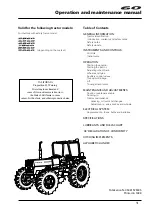
Hydraulic System
Maintenance
Hydraulic System Safety
•
Seek immediate medical attention if fluid is injected
into skin. Injected fluid must be surgically removed
within a few hours by a doctor.
•
Ensure that all hydraulic-fluid hoses and lines are
in good condition and all hydraulic connections
and fittings are tight before applying pressure to
the hydraulic system.
•
Keep your body and hands away from pinhole
leaks or nozzles that eject high-pressure hydraulic
fluid.
•
Use cardboard or paper to find hydraulic leaks.
•
Safely relieve all pressure in the hydraulic system
before performing any work on the hydraulic
system.
Checking the Hydraulic
Lines and Hoses
Service Interval:
Before each use or daily
Check the hydraulic lines and hoses daily for
leaks, kinked lines, loose mounting supports, wear,
loose fittings, weather deterioration, and chemical
deterioration. Make all necessary repairs before
operating.
Hydraulic-Fluid
Specifications
Recommended fluid:
Toro Premium
Transmission/Hydraulic Tractor Fluid (available in
5-gallon pails or 55-gallon drums. See the
Parts
Catalog
or contact an authorized Toro distributor for
part numbers.)
Alternate fluids:
If the Toro fluid is not available,
Mobil® 424 hydraulic fluid may be used.
Note:
Toro does not assume responsibility for
damage caused by improper substitutions.
Note:
Many hydraulic fluids are almost colorless,
making it difficult to spot leaks. A red dye additive
for the hydraulic-system fluid is available in 20 ml
(2/3 fl oz) bottles. 1 bottle is sufficient for 15 to 22 L
(4 to 6 gallons) of hydraulic fluid. Order Part Number
44-2500 from your authorized Toro distributor.
Checking the
Hydraulic-Fluid Level
Service Interval:
Before each use or daily
1.
Fully raise all hydraulic attachment to the
transport position.
2.
Prepare the machine for maintenance; refer to
Preparing for Maintenance (page 44)
.
3.
Remove the hood; refer to
(page 45)
.
4.
Clean the area around the hydraulic-tank
dipstick and cap (
).
g366283
Figure 93
1.
Dipstick and cap
5.
Remove the dipstick and cap from the tank and
wipe it with a clean rag.
6.
Insert the dipstick into the tank (
7.
Remove dipstick and cap (
) and check
the level of the fluid.
Note:
You should see the fluid level is between
the L
OW
mark and the F
ULL
mark on the dipstick.
8.
If the fluid level is low, add the specified hydraulic
fluid to the reservoir to raise the level to the F
ULL
mark on the dipstick.
9.
Install the dipstick and cap (
) into the
tank.
10.
Install the hood; refer to
(page 45)
.
58







































